跨文化交际期末考试复习题
跨文化交际期末考试题【新】
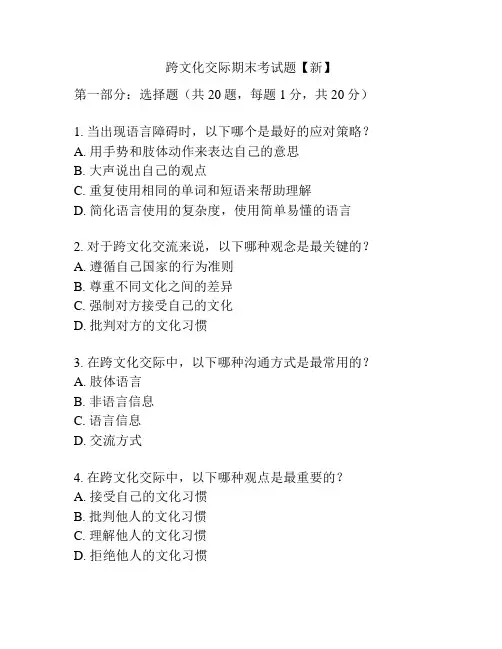
跨文化交际期末考试题【新】第一部分:选择题(共20题,每题1分,共20分)1. 当出现语言障碍时,以下哪个是最好的应对策略?A. 用手势和肢体动作来表达自己的意思B. 大声说出自己的观点C. 重复使用相同的单词和短语来帮助理解D. 简化语言使用的复杂度,使用简单易懂的语言2. 对于跨文化交流来说,以下哪种观念是最关键的?A. 遵循自己国家的行为准则B. 尊重不同文化之间的差异C. 强制对方接受自己的文化D. 批判对方的文化习惯3. 在跨文化交际中,以下哪种沟通方式是最常用的?A. 肢体语言B. 非语言信息C. 语言信息D. 交流方式4. 在跨文化交际中,以下哪种观点是最重要的?A. 接受自己的文化习惯B. 批判他人的文化习惯C. 理解他人的文化习惯D. 拒绝他人的文化习惯5. 在一个跨文化交际的场合中,以下哪个应该是最高的优先级?A. 活跃的参与B. 语言水平的熟练程度C. 适应当地的礼仪和行为准则D. 强调自己的文化背景6. 以下哪个是一个跨文化交际中最常见的问题?A. 礼貌和礼仪的不同B. 文化差异造成的文化霸权C. 认知差异的沟通问题D. 语言障碍7. 以下哪种服务最适合在跨文化交际中使用?A. 机器翻译服务B. 优先选择专业的口译和翻译服务C. 通过朋友或熟人的介绍寻找帮助D. 利用在线社交媒体解决问题8. 在跨文化交际中,以下哪种事情应该避免?A. 尊重并遵循当地的礼仪和行为准则B. 试图改变或批判当地的文化习俗C. 沿用自己的文化行为准则D. 关注当地的文化和语言细节9. 在跨文化交际中,以下哪种技巧是最有用的?A. 避免使用简单易懂的语言B. 直截了当地表达自己的观点C. 关注当地的非语言行为和信号D. 尝试使用当地的单词和短语10. 当尝试与跨文化背景的人交流时,以下哪种能力是最重要的?A. 语言能力B. 理解当地文化的背景C. 思考和行动的方式D. 批判思维11. 在跨文化交际中,以下哪个语言问题最常见?A. 不同的拼写和拼音B. 不同的语法结构和单词含义C. 方言和口音D. 礼仪和交际方式12. 在跨文化交际中,以下哪个观念是最必要的?A. 尊重当地的文化背景B. 认为自己的文化优越C. 轻视当地的命令和指示D. 批判当地文化的错误13. 在跨文化交际中,以下哪个事情是至关重要的?A. 去熟悉当地的文化和语言背景B. 寻找机会批判当地的文化习惯C. 坚持自己的文化行为准则D. 放松身心,自然而然的融入当地环境14. 在跨文化交际中,以下哪种行为应该被避免?A. 尊重他人的文化背景B. 没有认真倾听对方的观点C. 关注当地的语言和文化细节D. 对对方的文化行为进行批评和评价15. 在跨文化交际中,以下哪种观念是最重要的?A. “我们的文化最好”B. “我们的文化最好,但我们也能接受其他文化”C. “所有文化都有其独特之处,值得尊重和理解”D. “其他文化与我们的文化无关”16. 在跨文化交际中,以下哪种行为应该被避免?A. 关注和遵守当地的礼仪和行为准则B. 尝试使用当地的语言和单词C. 尊重和理解当地的文化习俗D. 批判和否定当地的文化习俗17. 在一个跨文化交际的场合中,以下哪个应该是最高的优先级?A. 展示自己的文化背景B. 关注当地的语言和文化细节C. 认真倾听对方的观点D. 强调自己优越的文化背景18. 在跨文化交际中,以下哪种事情应该被避免?A. 尊重所有人的文化背景B. 批判当地的文化行为C. 关注当地的非语言信号D. 使用当地的语言和单词19. 在跨文化交际中,以下哪种技巧是最有用的?A. 尊重当地的文化背景B. 试图改变当地的文化行为准则C. 使用自己的语言和单词D. 关注当地的微妙而又微小的语言和非语言信号20. 在跨文化交际中,以下哪种行为应该被避免?A. 关注当地的礼仪和行为准则B. 忽略当地的迷信和传统信仰C. 尊重当地的宗教和文化背景D. 沿用自己的文化行为准则第二部分:简答题(共5道题,每题4分,共20分)1. 解释什么是文化差异,并列举至少三个文化差异的例子?2. 解释为什么认知差异在跨文化交际中是一个重要的问题,并提供至少三个示例说明不同的认知差异会如何影响跨文化交流?3. 解释什么是非语言沟通,并列举至少三个非语言沟通的例子?4. 解释为什么跨文化交际中的措辞和用词是非常重要的,并提供至少三个示例说明,不同的词语和措辞可能导致文化差异。
跨文化交际期末考试复习题
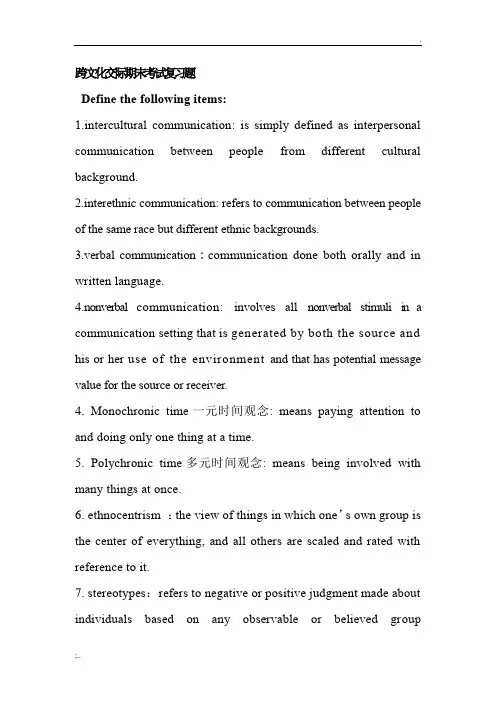
跨文化交际期末考试复习题Define the following items:1.intercultural communication: is simply defined as interpersonal communication between people from different cultural background.2.interethnic communication: refers to communication between people of the same race but different ethnic backgrounds.3.verbal communication:communication done both orally and in written language.4.nonverbal communication: involves all nonverbal stimuli i n a communication setting that is generated by both the source and his or her use of the environment and that has potential message value for the source or receiver.4. Monochronic time一元时间观念: means paying attention to and doing only one thing at a time.5. Polychronic time多元时间观念: means being involved with many things at once.6. ethnocentrism :the view of things in which one’s own group is the center of everything, and all others are scaled and rated with reference to it.7. stereotypes:refers to negative or positive judgment made about individuals based on any observable or believed groupmembership.针对目标群体成员所特有的正面或方面的判断。
跨文化交际复习考试题及答案
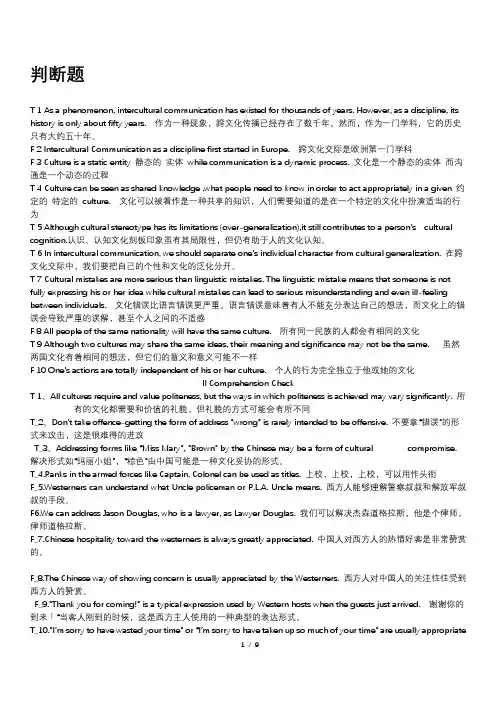
T 1 As a phenomenon, intercultural communication has existed for thousands of years. However, as a discipline, its history is only about fifty years. 作为一种现象,跨文化传播已经存在了数千年。然而,作为一门学科,它的历史只有大约五十年。
F6.We can address Jason Douglas, who is a lawyer, as Lawyer Douglas. 我们可以解决杰森道格拉斯,他是个律师,律师道格拉斯。
F_7.Chinese hospitality toward the westerners is always greatly appreciated. 中国人对西方人的热情好客是非常赞赏的。
T 4 Culture can be seen as shared knowledge ,what people need to know in order to act appropriately in a given 约定的 特定的 culture. 文化可以被看作是一种共享的知识,人们需要知道的是在一个特定的文化中扮演适当的行为
T_4.Ranks in the armed forces like Captain, Colonel can be used as titles. 上校,上校,上校,可以用作头衔
F_5.Westerners can understand what Uncle policeman or P.L.A. Uncle means. 西方人能够理解警察叔叔和解放军叔叔的手段。
T_2、Don’t take offence-getting the form of address ”wrong” is rarely intended to be offensive. 不要拿“错误”的形式来攻击,这是很难得的进攻
跨文化交际期末考问题及答案
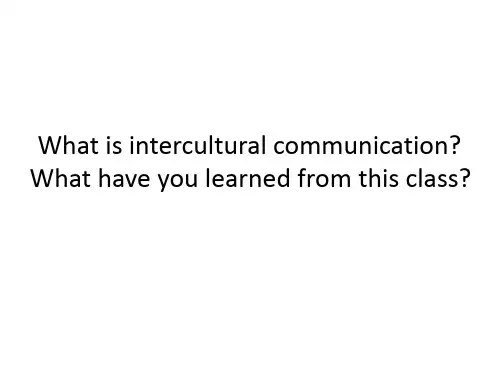
Chinese: To show respect to the other or give
the face to the other
American:Illegal as the child abuse
Warm up
• 2. What is a good friend in Chinese and
mind, you can buy me a red rose to show your apology.” Then the man bought her a rose and they went to a hotel together to study more about the skirt.
What is intercultural communication? What have you learned from this class?
3. Intercultural Communication
• Samovar & Porter
Intercultural communication is communication between people whose cultural perceptions and symbol systems are distinct enough to alter the communication event. intercultural communication refers to any communication between two members of any cultural communities.
• Non verbal communication includes those important but unspoken signals that individuals exhibit, specifically: body language (encompassing carriage/posture, appearance, listening, eye contact), hand gestures, and facial expressions. Non-verbal communication makes up the majority of the communication that we engage is, although it isn't always conscious.A very good example is:
跨文化交际导论期末考试题
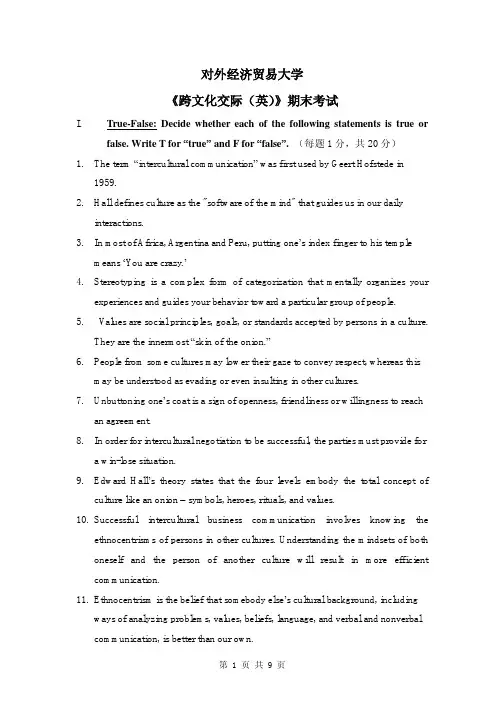
对外经济贸易大学《跨文化交际(英)》期末考试I.True-False: Decide whether each of the following statements is true orfalse. Write T for “true” and F for “false”.(每题1分,共20分)1.The term “intercultural communication” was first used by Geert Hofstede in1959.2.Hall defines culture as the "software of the mind" that guides us in our dailyinteractions.3.In most of Africa, Argentina and Peru, putting one’s index finger to his templemeans ‘You are crazy.’4.Stereotyping is a complex form of categorization that mentally organizes yourexperiences and guides your behavior toward a particular group of people.5.V alues are social principles, goals, or standards accepted by persons in a culture.They are the innermost “skin of the onion.”6.People from some cultures may lower their gaze to convey respect, whereas thismay be understood as evading or even insulting in other cultures.7.Unbuttoning one’s coat is a sign of openness, friendliness or willingness to reachan agreement.8.In order for intercultural negotiation to be successful, the parties must provide fora win-lose situation.9.Edward Hall’s theory states that the four levels embody the total concept ofculture like an onion – symbols, heroes, rituals, and values.10.Successful intercultural business communication involves knowing theethnocentrisms of persons in other cultures. Understanding the mindsets of both oneself and the person of another culture will result in more efficient communication.11.Ethnocentrism is the belief that somebody else’s cultural background, includingways of analyzing problems, values, beliefs, language, and verbal and nonverbal communication, is better than our own.12.People in the United States place a greater emphasis on history and do not likechange as compared with people of Asian and Latin cultures.13.When dealing with German business people, you should avoid jokes and otherforms of humor during the actual business sessions.14.In the business circle, American business people use first names immediately.panies should avoid sending female employees to the Middle East, as inArab countries men may refuse to work with women.16.In Southeast Asia, you should avoid presenting your business card with your righthand.17.When accepting a business card, German business people carefully look at thecard, observe the title and organization, acknowledge with a nod that they have digested the information, and perhaps make a relevant comment or ask a polite question.18.The OK sign may be interpreted as asking for money by Japanese businesspeople.19.Nonverbal communication is important to the study of interculturalcommunication because a great deal of nonverbal behavior speaks a universallanguage.20.In short, intercultural communication competence requires sufficient awarenessknowledge, motivations, and skills. Each of these components alone is sufficient to achieve intercultural communication competence.II.Translation: Translate the following Chinese terms into English and English terms into Chinese.(每题1分,共20分)1. stereotypes2. paralanguage3. ethnocentrism4. masculinity5. high-context culture6. monochronic time7. speech act 8. conversation taboos9. vocal qualifiers 10. power distance11. 译码12. 偏见13. 文化震惊14. 不确定性回避15. 概念意义16. 语用错误17. 礼貌原则18. 归纳法19. 空间语言20. 礼仪与礼节III.Multiple Choice: Choose the ONE appropriate answer.(每题1分,共20分)1. Understanding another culture ________.a.enables businesspeople to know why foreign associates believe and actas they dob.is best achieved through “do’s and don’ts” listsc.is important for businesspeople because they can appear to be betterinformedd.isn’t necessary for businesspeople2. Non-linear languages ______.a.are object orientedb.see time as a continuum of present, past and futurec.are circular, tradition oriented and subjectived.lead to short-range planning in business practices3. Which statement about values is incorrect?a. V alues are social principles, goals, or standards accepted by persons in aculture.b. V alues are learned by contacts with family members, teachers, andreligious leaders.c. V alues will be influenced by what is seen on television or read innewspapers.d. People in various cultures have basically similar values.4. People from cultures that follow the monochronic time system tend toa. do one thing at a time.b. be committed to people.c. borrow and lend things often.d. build lifetime relationships.5. Which statement regarding haptics is incorrect?a. In Thailand, it is offensive to touch the head.b. Japan is considered a "don't touch" culture.c. Greece is considered a "touch" culture.d. In Latin American countries, touching between men is unacceptable.6. The opinion that everyone has a position and clearly defined privileges is _____.a. a view of hierarchical structure of social relationshipb. a view of group orientation structure of social relationshipc. a view of individual orientation structure of social relationshipd.none of the above7. General guidelines to follow when conversing with someone from anotherculture include all of the following except:a. politics is a safe topic in most cultures.b. avoid telling jokes.c. avoid personal questions.d. keep the conversation positive.8. Which statement best describes an incorrect handshake?a. In the U.S., a handshake should be firm.b. An Asian handshake is usually gentle.c. Germans repeat a brusque handshake upon arrival and departure.d. A British handshake is firm and repeated frequently.9. Which statement referring to thought patterns is incorrect?a. Asians typically use the inductive method of reasoning.b. Thought patterns impact oral communication.c.When using the deductive method of reasoning, one starts with the factsand goes to generalizations.d. Recognizing different thought patterns is important in negotiation withdifferent cultures.10. Which statement is incorrect?a. Costly business blunders are often the result of a lack of knowledge ofanother culture's nonverbal communication patterns.b. Processes of reasoning and problem solving are the same in all cultures.c.Attitudes toward time and use of space convey nonverbal messages inintercultural encounters.d.When in another culture, an appropriate caution would be to watch thebehavior of the persons you are talking with and match their style.nguage is important because it _____a.helps us shape concepts, controls how we think, and controls how weperceive others.b.allows us to be understood by foreigners.c.is determined by colonialism.d.is stable, easily understood, and free of diversity.12. Which of the following countries uses high-context language?a.Canadab.Germanyc.Japand.United States13. Slang is generally _____a.understood by everyone.b.spoken by the masses.c.easily translated.ed by subgroups.14. Nonverbal communication does not include _____a. chromatics.b. chronemics.c.haptics.d. semantics.15. Dominance, harmony, and subjugation are all value orientations that correspond to which of the following cultural problems?a.What is the nature of human beings?b.What is the relationship of humans to nature?c.What is the orientation of humans to time?d.What is the human orientation to activity?16. Proverbs are significant to the study of intercultural communicationbecause_______.a.they provide a compact description of a culture’s valuesb.they tell a great deal about what a culture praises and what it rejectsc.they unite a people with the wisdom of their ancestorsd.all of the above17. Which statement highlights weak uncertainty avoidance?a. One group's truth should not be imposed on others.b. Scientific opponents cannot be personal friends.c. Citizen protest should be repressed.d. Negative attitudes are expressed toward young people.18. The main idea of the Sapir-Whorf Hypothesis is thatnguage is just a device for reporting a person's experience.b.two languages can represent the same social reality.c.the social reality can be conveyed to a person who does not speak thelanguage.nguage functions as a way of shaping a person's experience.19. Many multinational firms find that cultural shock can be alleviated bya. sending only top executives abroad.b. sending only young, single associates on overseas assignments.c. testing associates to see who is most qualified.d. selecting employees for overseas assignments who possess certainpersonal and professional qualifications.20. Which of the following statement is incorrect?a.Knowing cultural variations in the use of silence is helpful whenconversing with persons in another culture.b.We need to keep things in perspective and not get offended each time wedeal with someone who has a different attitude toward touchingc.Good advice when communicating with persons in other cultures is tokeep gestures to a minimumd.Although oral communication varies from culture to culture, non-verbalcommunication is almost always interpreted the same in each culture.IV.Answer the following essay question. (共20分)Compare and contrast the following proverbs from two different cultures: “It is the duck that squawks that gets shot”and “The squeaky wheel gets the grease.” How do people from these cultures perceive silence and talk? In light of their different perceptions, how might they view each other? What problems might arise in their interactions?V.Case Analysis: Analyze the following conversation from an intercultural perspective.(共20分)The following conversation took place between two Chinese friends.A: We’re going to New Orleans this weekend.B: What fun! I wish we were going with you. How long are you going to be there?A: Three days.B: Do you need a ride to the airport? I’ll take you.A: Are you sure it’s not too much trouble?B: No, no. It’s no trouble at all.Case Analysis: Analyze the following conversation from an intercultural perspective.参考答案及评分标准A卷VI.True-False: Decide whether each of the following statements is true or false. Write T for “true” and F for “false”.(每题1分,共20分)1. F2. F3. F4. T5. T6. T7. T8. F9. F 10. T11. F 12. F 13. T 14.T 15. T 16. F 17. F 18. T 19. T 20. FVII.Translation: Translate the following Chinese terms into English and English terms into Chinese.(每题1分,共20分)1. stereotypes 定势/刻板印象2. paralanguage 辅助语言/副语言3. ethnocentrism 民族中心主义4. masculinity男性特征5. high-context culture高语境文化6. monochronic time单一时间观念7. speech act 言语行为8. conversation taboos对话禁忌9. vocal qualifiers 声音修饰10. power distance权力距离11. 译码 decoding 12. 偏见 prejudice13. 文化震惊cultural shock 14. 不确定性回避 uncertaintyavoidance15. 概念意义denotational meaning 16. 语用错误pragmatic failure17. 礼貌原则the Politeness Principle 18. 归纳法inductivepattern19. 空间语言spatial language/proximics 20. 礼仪与礼节etiquetteand protocolVIII.Multiple Choice: Choose the ONE appropriate answer.(每题1分,共20分)1. a2. a3. d4. a5. d6. a7. a8. d9. c 10. b11. a 12. c 13. d 14. d 15. b 16. d 17. a 18. d 19. d 20. dIX.Answer the following essay question. (共20分)测试重点:Compare and contrast the proverbs “It is the duck that squawks thatgets shot”and “The squeaky wheel gets the grease.”The former is an English proverbwhile the latter is a Chinese proverb. In light of their different perceptions, the twocultures might differ in terms of silence and talk etc. and problems might arise in theirinteractions.评分标准:从以上角度进行分析,其他根据具体答题情况酌情。
跨文化交际期末考问题及答案共47页

谢谢!
47
26、要使整个人生都过得舒适、愉快,这是不可能的,因为人类必须具备一种能应付逆境的态度。——卢梭
▪
27、只有把抱怨环境的心情,化为上进的力量,才是成功的保证。——罗曼·罗兰
▪
28、知之者不如好之者,好之者不如乐之者。的决心能够抵得上武器的精良。——达·芬奇
▪
30、意志是一个强壮的盲人,倚靠在明眼的跛子肩上。——叔本华
跨文化交际期末考问题及答案
41、俯仰终宇宙,不乐复何如。 42、夏日长抱饥,寒夜无被眠。 43、不戚戚于贫贱,不汲汲于富贵。 44、欲言无予和,挥杯劝孤影。 45、盛年不重来,一日难再晨。及时 当勉励 ,岁月 不待人 。
▪
跨文化交际期末复习
跨文化交际期末复习判断1 the iceberg model of culture implies that it is very difficult to understand a culture thoroughly文化的冰山模式意味着要彻底理解文化是非常困难的。
( T )2 culture is innate as soon as a person is born一个人出生就有文化( F )3 people may sometimes get confused about his or her cultural identity人们有时会对他或她的文化身份感到困惑。
( T )4 scholars prefer the term subculture to co-culture in describing a culture which exists witnin a dominant culture在描述一种存在显性文化的文化时,学者们倾向于亚文化到共同文化。
( F )components :sender,encoding,message,chann el,noise,decoding,feedback,and context通信过程由九部分组成:发送方、编码、消息、信道、噪声、解码、反馈和上下文。
( T )10 No two of us can assume that our sensations are the same我们谁也不能假定我们的感觉是一样的。
( T )11 people may possess different sensing of the same smell人们可能对同一气味有不同的感觉。
( T )12 Our perception are influenced by who we are,includeing the accumulation of our experience我们的感觉被我们是谁的影响,包括我们的经验的积累( T )13 we give meaning to or decode the information that we have selected andorganized during the selection stage 我们在选择阶段对我们选择和组织的信息给予意义或解码。
跨文化期末考试试题
跨文化期末考试试题# 跨文化期末考试试题## 第一部分:选择题1. 跨文化交流中,以下哪项不是文化适应的策略?- A. 积极学习新文化的语言- B. 避免与不同文化背景的人交流- C. 尊重并理解不同文化的差异- D. 尝试融入新的文化环境2. 在跨文化沟通中,以下哪个概念指的是不同文化背景下人们的行为和交流方式?- A. 文化冲突- B. 文化适应- C. 文化休克- D. 文化维度3. 根据霍夫斯泰德的文化维度理论,以下哪个维度描述了社会对个人成就的重视程度?- A. 权力距离- B. 个人主义与集体主义- C. 男性化与女性化- D. 不确定性回避## 第二部分:简答题1. 简述跨文化能力的重要性,并举例说明在国际商务中如何应用跨文化能力。
2. 解释什么是文化休克,并描述一个人在经历文化休克时可能经历的阶段。
## 第三部分:案例分析题阅读以下案例,并回答问题:案例背景:张华是一家中国公司的市场部经理,最近被派往德国分公司工作。
在德国,他发现同事们在会议中非常直接,经常提出批评意见,这与他在中国的工作经验大相径庭。
问题:1. 张华可能会遇到哪些跨文化沟通的挑战?2. 他可以采取哪些策略来适应德国的工作环境?## 第四部分:论述题在全球化的背景下,跨文化交流变得越来越重要。
请论述跨文化交流在国际关系中的作用,并探讨如何培养个人的跨文化沟通能力。
## 第五部分:写作题请以“跨文化理解在全球化时代的价值”为题,写一篇不少于800字的论文。
论文应包括以下要点:- 跨文化理解的定义和重要性- 全球化对跨文化理解的影响- 个人和组织如何提升跨文化理解能力- 跨文化理解在解决国际冲突中的作用请注意,以上内容仅为示例,实际考试题目可能会有所不同。
考生应根据具体课程内容和教学大纲进行复习和准备。
跨文化交际期末试题及答案
跨文化交际期末试题及答案试题一:1. 跨文化交际的概念是什么?2. 跨文化交际中可能遇到的困难有哪些?如何应对?3. 请列举两个不同文化背景下的沟通误解,并说明产生误解的原因。
4. 如何加强跨文化交际的能力?5. 请描述一次成功的跨文化交际经历,并谈谈你从中学到了什么。
答案如下:1. 跨文化交际是指不同文化背景的个体之间进行信息传递和相互理解的过程。
它涉及到语言、行为、价值观等方面的差异,需要在尊重和理解对方文化的基础上进行有效交流。
2. 在跨文化交际中,可能遇到语言障碍、文化差异导致的误解、价值观冲突等困难。
要应对这些困难,首先需要学习对方的语言,尽量减少语言障碍。
其次,要了解对方文化的特点,避免由于文化差异而引起的误解。
最后,要保持开放心态,尊重不同的价值观,通过倾听和理解来解决潜在的冲突。
3. (1)例子一:在西方国家,直接表达意见被视为开放和直率的表现,但在东方文化中,过于直接的表达会被视为冒犯和不尊重他人。
这种差异可能导致沟通中的误解和冲突。
原因:西方文化注重个人主义和直接表达,而东方文化注重集体主义和含蓄表达。
双方的价值观和文化习惯差异导致了沟通误解。
(2)例子二:在某些非洲国家,左手被视为不洁之手,不可用于触摸或传递物品;而在西方国家,左手并没有特殊的意义。
如果一个西方人无意中用左手递给非洲人物品,可能会被视为不尊重对方的文化。
原因:非洲文化中,左手被认为是不洁的,使用左手被视为不尊重和不礼貌的行为。
而在西方文化中,没有类似的禁忌。
4. 加强跨文化交际的能力需要多方面的努力。
首先,要增加对不同文化背景的了解,包括语言、历史、价值观等方面。
其次,要培养跨文化沟通的敏感性和意识,学会观察和尊重不同文化之间的差异。
此外,多与来自不同文化的人交流,积累经验和技巧,不断提升自己的跨文化交际水平。
5. 描述一次成功的跨文化交际经历,得以学习到很多。
我在一次国际研讨会上结识了一位来自日本的研究者。
跨文化交际期末复习
跨文化交际期末复习Unit1Term interpretationEconomic globalization 经济全球化The integration of national economics of national economics into the international economy through trade, foreign direct investment, capital flows, migration, and the spread of the technology.Barter System 物物交换Farming communities traded their surplus produce in exchange for products and services without the medium of moneyGlobal Village地球村All the different parts of the world from one community linked together by electronic communications, especially the Internet.Melting pot大熔炉To assimilate the cultures of different backgroundsCultural Diversity文化多样性Countries have been mixed instead of assimilateBrief Answer1.What are the four trends that lead to the development of the global village?1)convenient transportation systems2)Innovative communication systems3)Economic globalization4)widespread migration2.What are the three aspects where the cultural differences exist?(选择)1)verbal difference; language, thought patterns2)Non-verbal communication; body-language, time concept, spacious language, paralanguage…3)values; world views, beliefs, attitudes…Unit 1 后半Term interpretationCultureCulture can be seen as shared knowledge, what people need to know in orderto act appropriately in a given cultureEnculturation 文化习得The process of learning one’s own cultureAcculturation文化适应Adapt the cultures learning by the other culturesPs:文化习得,文化适应需要对比Ethnocentrism 文化中心主义Think your culture is superior to the othersBrief AnswerWhat are the three ingreduents of culture?Products, behaviors, and ideas.How to understand cultural iceberg?Culture like an iceberg can be divided into two parts: culture above the waterline and culture below the waterline. Culture above the waterline is explicit, visible, tangible, easy to change with time, a tip of the iceberg. Culture below the waterline is implicit, invisible, intangible, hard to change with time, the majorityWhat are the characteristic of culture?Culture is dynamic, shared, learned, ethnocentric(文化中心主义)Unit 2Term interpretationSource发出信息的人Person who send out informationEncoding 编码The process of putting your thoughts into symbolsMessageEncoded thoughtsChannel渠道The way the message is deliveredDecoding解码Assign a meaning to the wordsReceiverPerson who attends to the informationContext内容The physical environment that surround usBrief AnswerWhat are the three characteristics of communication?(简答/选择)Communication is transactional(互换性), dynamic, irreversible, symbolic, systematic and contextual.What are the three basic aspects to communication? And on which aspect does the success ofinterpretation communication greatly depend on?Our individual personality, the culture we operate in, the physical environment that surrounds us.Depend on the culture we operate in.Unit2后半Term interpretationVerbal Intercultural Communication非言语行为People from different cultural backgrounds communicate with other people through languagePragmatics语言学The study of the effect that language has on human perceptions(感知)and behaviorShort answer question1.How is Chinese addressing different from American addressing?In Chinese, the surname is put before the given name.In American, vice versa, the name order.In recent years, many English-speaking people tend to address others by their given names, even when meeting for the first time. But in Chinese, we tend to address each other with the full name.Another common Chinese form of address is the use of a person’s title office, or professionTherefore, one can conclude that the Chinese customs of addressing members with the kinship terms(亲戚关系) even not related by blood or marriage 2.Who should be introduced first in the west?The senior, the female, the guest3.How is Chinese hospitality different from American hospitality?A: In China, a guest usually observes the principle of avoiding bringing trouble to the host.In American, in contrast, it is the host who tries to avoid interferingin guests’ freedom of action by leaving room for the guests to make choices.B: The Chinese host usually goes to trouble to make sure there is something left after the meal; the “wastefulness” of this practice has been criticized in American, and some advocate ordering more sensible quantities.PS: 1.appropriate topics i .e Jim Smith—Uncle Jim2. response to complaint3. make apologyUnit3Term interpretationA cultural assumption 文化定式A cultural assumption Is when we assume that a person has particular values and attitudes based on their cultural backgrounds.Brief AnswerHow would Americans misunderstand the Chinese responses to the compliments?1.In the first case, the implication was that the praisor had poor judgement2.The praisor was not sincere3.The Chinese would be suspected of “fishing for compliments”Why are the Chinese reluctant to pay a compliment?1.The same compliment was given by a Chinese man to a Chinese woman, the compliment can be.taken as a kind of flirtation(调戏)2..People are cautious about drawing a line between compliment and flattery.3.A positive subtle form of request.(重要)How is the Chinese different from Americans in expressing gratitude?1.Chinese people don't usually say "thank you" to those who are very close and who are in a lower position. Thank you is very common in American, so they tend to thank people all day long regardless of relationship2.Traditional Chinese customs don't require people to express thanks for the small favorsThe Americans would thank you all the way for very small and most ordinary things.Unit4Term interpretationSemantics 语意学The study of the meaning of wordsDenotation 本义The literal(字面意义) meaning or definition of a word-the explict, particular, defined meaningConnotation 延伸义Extended meaning of associated meanings, the suggestive(隐含)meaning. Taboo 禁忌语Some words,objects or actions that you should avoid in a certain culture. Euphemism 委婉语The act of substituting a mild, indirect or vague term for one considered harsh, blunt, or offensiveBrief AnswerWhat are the 4 major verbal differences between Chinese and English ?1.A term in one language doesn’t necessarily have a counterpart(对等的人事物) in the other language.2.Words or terms in both languages appear to refer to the same object or concept only on the surface, but actually refer to quite different things3.Things or concepts are represented by one or perhaps two terms in one language, but by many more terms in the other language, for example, finer distinctions in the other language4.Terms have more or less the same primary meaning, but have secondary or additional meanings that may differ considerably from each other.PS:make some examples for the differencesThe thought patterns of people around the worldThe United States were more linear and directThe Semitic individuals solved problems using a combination of tangential and semi-direct approaches,Romance is circuitous(迂回) approachRussians employed a combination of indirect and circuitous approachesUnit5(选择为主)Term interpretationChroxemics 时间学Mono chronic time = M-time 单时性文化Emphasis on schedules, segmentation and promptness(efficiency)and punctuality. It features one event at a time.Polychronic time = P-time 多时性文化practiced by most other peoples is less rigid and clock-bound. People from P-time cultures schedule several activities at the same time ,and time for them is more flexible and more human-centeredProxemics 空间学the perception and use of spaceKinesics 身势学more than just hand or arm gestures ;it refers to any little movement of any part of the bodyParalanguage 副语言language lies between verbal and nonverbal communication. It involves sounds but not words ,it means the set of nonphonemic properties of speech ,such as speaking tempo(节奏) ,vocal pitch(音高) and intonational contours (语音语调)Brief AnswerWhere are the different features of M-time and P-time ?M-time :means paying attention to and doing only one thing at a time. Emphasis on schedules, segmentation and promptness(efficiency)and punctuality. It features one event at a time.P-time: practiced by most other peoples is less rigid and clock-bound. People from P-time cultures schedule several activities at the same time ,and time for them is more flexible and more human-centeredPS: 1.touch/nontouch culture& long/short body distancei.e Arab—touch/shortUSA—nontouch/medium2.seat—China: facing the door is distinguishedUSA: acrossing the cornerUnit6Brief AnswerWhat is the difference between sex and gender?书P120表6.1Sex(生理性别):biological(生理的),permanent and with an individual propertyGender(社会性别):socially-constructed, varied over time and across cultures and with a social and relational qualityIn all, gender and sex are not synonymous.What are the two primary influences on the socialization?1..family communication, particularly between mother and children2.recreational interaction among childrenUnit7(以案例分析为主)Brief AnswerIdentify the contrast between high-context and low-context culture and then use it to interpret the difference between American and Japanese or Chinese negotiating style?1.Negotiation atmosphere:American: efficient, professionalism(职业精神)and compromise(妥协,让步)Japanese: socializing, trustChinese: socialization2.DetailAmerican: the facts, written agreements or contrastJapanese: fewer specific issues and less detail oriented, brief written agreementsChinese: general written agreementsmunication styleAmerican: more interested in logical arguments than in the people they are dealing with dislike silenceJapanese: encourage covert, fragmentedChinese: avoid openly confront conflict4.Cultural variations in selecting negotiators:American: technical expertise :younger negotiators are common; women are included; having full authority to make decisionsJapanese:(Chinese): Status, knowledge, age, seniority5.Problem-solving ProcessAmerican:universal problem solvers; rational thinking and concrete data, utilize a factual inductive style of persuasionJapanese: consensus-buildingChinese: high level authoritiesanizational StructureAmerican:task-related stage is the most important; negotiating outcomes depend on events at the negotiation tableJapanese: pre-negotiation is slowly and cautiously; mediator is used Chinese: concession only comes at the endUnit9Brief AnswerWhat contrasting world views can be drawn from Buddhism and Christianity?1.Chiristans sees each one was born with sins and therefore we should salvage ourselves(自我拯救). The salvation of the individual is achieved through hard work and piety.Christianity recognizes the importance of work and free ownership of property.2.Buddhists believes that there is a supreme and wonderful truth that the universes runs based on a dynamic balance.They don’t attach themselves to the impermanent objects and the pursuit of material well-being. Thus, little support is accorded to free enterprise..(重要)What are the American/Chinese cultural values like in terms of Cultural Orientation put forward by Kluekhohn and Strodthbeck?1.Human nature(人生) is evil but perfectible (American)Good but corruptible (Chinese)2.Relation to the natureHuman beings can/should master/conquer with nature (American)Live harmoniously with nature (Chinese)3.Sense of timeAmericans are future oriented.Chinese are past oriented.4.Attitudes toward work and human activityAs to Americans, doing leads to external/achievementsChinese,being-and-becoming is a kind of spiritual good of inner harmony and peace.5.Social relationshipAmerican: Self is more important than group (individualism) Chinese: In cultures with group values, people make decisions by consemsus (重要)Identify the features of each of four Hofstede’s cultural dimensions and apply it in the case study辨别+分析+结合案例1.individualism VS collectivism (个人/集体主义)2.low power distance VS high power distance(远/近权力距离)3.masculinity VS femulinity (男性/女性文化)4.low uncertainty avoidance VS high uncertainty avoidance (不确定性)5.high context culture VS low context culture考试题型1.T/F Exercise A Unit1-9原题2.Choice (单选) Exercise E 1/3会变 1/3 Unit5 细节题Smile—friendness (USA) —sharow (Korea)The land of smile—Thailand1/3 从简答题演变3.Term matching (术语匹配) 26选104.英译中预言,习语 Unit1-4 Exercise C P74-76(见下)1.新官上任三把火。
- 1、下载文档前请自行甄别文档内容的完整性,平台不提供额外的编辑、内容补充、找答案等附加服务。
- 2、"仅部分预览"的文档,不可在线预览部分如存在完整性等问题,可反馈申请退款(可完整预览的文档不适用该条件!)。
- 3、如文档侵犯您的权益,请联系客服反馈,我们会尽快为您处理(人工客服工作时间:9:00-18:30)。
跨文化交际期末考试复习题Define the following items:1.intercultural communication: is simply defined as interpersonal communication between people from different cultural background.2.interethnic communication: refers to communication between people of the same race but different ethnic backgrounds.3.verbal communication:communication done both orally and in written language.4.nonverbal communication: involves all nonverbal stimuli i n a communication setting that is generated by both the source and his or her use of the environment and that has potential message value for the source or receiver.4. Monochronic time一元时间观念: means paying attention to and doing only one thing at a time.5. Polychronic time多元时间观念: means being involved with many things at once.6. ethnocentrism :the view of things in which one’s own group is the center of everything, and all others are scaled and rated with reference to it.7. stereotypes:refers to negative or positive judgment made about individuals based on any observable or believed groupmembership.针对目标群体成员所特有的正面或方面的判断。
8. encoding is the act of putting an idea or thought into a code..编码:是指将思想转换成代码的行为过程。
9.Culture identity : refers to one’s sense of belonging to a particular culture or ethnic group.文化身份:指有意识地把自己归为某一特定文化或种族群体。
10.Subculture are formed by groups of people possessing characteristic traits that set apart and distinguish them from others within a larger society or dominant culture.亚文化:具有能在更大的一个社会范围内或主流文化中使自己有别于他人的特点的人类群体所形成的文化。
11.Culture shock文化震惊: is a feeling of frustration, uneasiness, or uncertainty that many people experience in unknown settings.12.Taboo禁忌语:refers to some objects, words or actions that are avoided by a particular group of people, or in certain culture for religious or social reasons. 在特定文化中出于宗教或社会原因被一特定群体所避免使用的一些词语或行为。
13.Paralanguage副语言:refers to the rate , pitch and volume qualities of the voice,which interrupt or temporarily take the place of speech and affect the meaning of a message是与口语交际有关,指说的速度,音高,和质量,这些要素会打断或临时取代语言并影响信息的语意表达.munication noise干扰Any factor that hinders or distorts the reception of the message 15.Decoding解码The interpretative process of assigning meaning to a message. 16.Denotation:is the conceptual meaning of the word that designates or describes things, events or processes,etc.17.Connotation:refers to the emotional or stylistic associations thata word or phrase suggests in one’s mind.18.space bubbleWhen people are having conversation with someone else, they generally like to have a little bubble of space all around them. This little bubble of space extends one or two or even three feet all around our bodies. We tend to view this as our personal space,even if we never think about it.19.reverse culture shock: is the name people give to that feeling of not fitting into your home country,and you are especially at risk of it if you return home after living abroad for an extended time. Answer the following questions:(1).What is the difference between individualism and collectivism? An individualism culture is one in which people tend to view themselves as individuals and to emphasize the needs of individuals. It is regarded as a threat to the group and will result inpunishment by the group in some country like Japan.A collectivism culture is one in which people tend to view themselves as members of groups (families, work units,tribes, nations) and usually consider the needs of individuals. It values the group above the individual,and individuals have a responsibility to the group that supersedes individual needs or rights.(2).Features of culture1.Culture is learned behaviour2.Culture is usually acquired unconsciously3.Culture is shared among its members4.Culture is persistent and enduring5.Culture manifests itself both implicitly and explicitly6.Culture is adaptive and changeable7.Culture is relational(3).What is Culture shock .............p129Culture shock is a feeling of frustration, uneasiness, or uncertainty that many people experience in unknown settings.Culture shock is a multifaceted experience resulting from numerous stressors occurring in contact with a different culture. Cause of Culture shock1.Stress reaction 3.role shock2.Cognitive fatigue 4.personal shock(4).Components of Communication:SenderAny person that produces the messageSource交际邀请The source is the person with an idea he or she desires to communicate.Code代码Any systematic arrangement or comprehensive collection of symbolsEncoding编码Encoding is the act of putting an idea or thought into a code. Message编码信息The term message is the content of interactionChannel交际渠道The mode by which a message moves from the source of the message to the receiver of the message.Noise 干扰Any factor that hinders or distorts the reception of messages. Receiver交际接受The person that receives the message in the communication Response反应The reaction of the receiver to the decoded messageFeedback反馈Information generated by the receiver and made available to a source that allows the source to make qualitative judgments about the communication while it is taking place(5) What is nonverbal communication?Nonverbal communication involves all nonverbal stimuli in a communication setting that is generated by both the source and his or her use of the environment and that has potential message value for the source or receiver.(6). Culture difference on lexical levelThe lexical meaning of culture difference can largely be grouped into two types:denotation and connotation.Denotation is the conceptual meaning of the word that designates or describes things, events or processes,etc. It is the primary,explicit meaning given in the definition of a word in a dictionary.Connotation refers to the emotional or stylistic associations that a word or phrase suggests in one’s mind. It is the implicit, supplementary value which is added to the purely denotative meaning of a word or phrase.。
